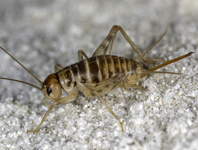Abstract
The chewing louse subgenus Cicchinella new subgenus is erected and described for species of Guimaraesiella Eichler, 1949, parasitizing Old World babblers (Leiothrichidae, Pellorneidae, Timaliidae). The subgenus is divided into three species groups based on chaetotaxy, head and genitalia of both sexes. Two species are redescribed: Guimaraesiella (Cicchinella) sehri (Ansari, 1955) from Trochalopteron lineatum lineatum (Vigors, 1831) and T. lineatum setafer (Hodgson, 1836), and Guimaraesiella (Cicchinella) avinus (Ansari, 1956) from Trochalopteron subunicolor subunicolor Blyth, 1843. In addition, 12 new species are described and illustrated: Guimaraesiella (Cicchinella) falcifrons n. sp. from Actinodura cyanouroptera sordidior (Sharpe, 1888); Guimaraesiella (Cicchinella) iuga n. sp. from Alcippe peracensis peracensis Sharpe, 1887; Guimaraesiella (Cicchinella) gombakensis n. sp. from Turdinus abbotti abbotti (Blyth, 1845); Guimaraesiella (Cicchinella) mcgrewi n. sp. from Alcippe morrisonia Swinhoe, 1863; Guimaraesiella (Cicchinella) tenella n. sp. from Cyanoderma ruficeps davidi (Oustalet, 1899); Guimaraesiella (Cicchinella) retusa n. sp. from Trochalopteron milnei sinianum Stresemann, 1930; Guimaraesiella (Cicchinella) philiproundi n. sp. from Trochalopteron melanostigma schistaceum (Deignan, 1938) and Trochalopteron peninsulae Sharpe, 1887; Guimaraesiella (Cicchinella) hannesundinae n. sp. from Heterophasia picaoides wrayi (Ogilvie-Grant, 1910); Guimaraesiella (Cicchinella) pallidobrunneis n. sp. from Heterophasia melanoleuca melanoleuca (Blyth, 1859); Guimaraesiella (Cicchinella) hampuslybecki n. sp. from Heterophasia auricularis (Swinhoe, 1864); Guimaraesiella (Cicchinella) scottvillai n. sp. from Liocichla steerii Swinhoe, 1877 and Guimaraesiella (Cicchinella) ambusta n. sp. from Leiothrix argentauris rubrogularis Kinnear, 1925. A key to identify the species of Cicchinella, and both a checklist and a host-louse list of the species of Cicchinella known from the Old World babblers are provided.
References
Ansari, R.A.M. (1955) Studies on the ischnoceron [sic] Mallophaga infesting birds in Pakistan. Proceedings of the Seventh Pakistan Scientific Conference, Biology, Bahawalpur, 42–62.
Ansari, R.A.M. (1956) A brief survey of Bruelia [sic] species (Ischnocera: Mallophaga) parasitic on the babblers and laughing thrushes (Timaliidae). Pakistan Journal of Health, 6, 133–174.
Bush, S.E., Weckstein, J.D., Gustafsson, D.R., Allen, J., DiBlasi, E., Shreve, S.M., Boldt, R., Skeen, R.H. & Johnson, K.P. (2015) Data supporting a molecular phylogeny of the hyper-diverse genus Brueelia. Data in Brief, 5, 1078–1091.
https://doi.org/10.1016/j.dib.2015.10.022
Bush, S.E., Weckstein, J.D., Gustafsson, D.R., Allen, J., DiBlasi, E., Shreve, S.M., Boldt, R., Skeen, R.H. & Johnson, K.P. (2016) Unlocking the black box of feather louse diversity: A molecular phylogeny of the hyper-diverse genus Brueelia. Molecular Phylogenetics and Evolution, 94, 737–751.
https://doi.org/10.1016/j.ympev.2015.09.015
Chen, C.-C. & Hsieh, F. (2002) Composition and foraging behavior of mixed-species flocks led by the grey-cheeked fulvetta in Fushan Experimental Forest, Taiwan. Ibis, 144, 317–330.
https://doi.org/10.1046/j.1474-919X.2002.00020.x
Cibois, A. (2003) Mitochondrial DNA phylogeny of babblers (Timaliidae). The Auk, 120 (1), 35–54.
https://doi.org/10.1642/0004-8038(2003)120[0035:MDPOBT]2.0.CO;2
Clements, J.F., Schulenberg, T.S., Iliff, M.J., Roberson, D., Fredericks, T.A., Sullivan, B.L. & Wood, C.L. (2015) The eBird/Clements checklist of birds of the world. Version 2015. Available from: http://www.birds.cornell.edu/clementschecklist/download/ (accessed 20 November 2015)
Clements, J.F., Schulenberg, T.S., Iliff, M.J., Roberson, D., Fredericks, T.A., Sullivan, B.L. & Wood, C.L. (2017) The eBird/Clements checklist of birds of the world. Version 2016. Available from: http://www.birds.cornell.edu/clementschecklist/download/ (accessed 17 July 2018)
Collar, N.J (2006) A partial revision of the Asian babblers (Timaliidae). Forktail, 22, 85–112.
Eichler, W. (1949) Phthirapterorum nova genera. Bolletino della Società Entomologica Italiana, 79, 11–13.
Eichler, W. (1951) Die Federlinge der Drosseln. In: Bedeutung der Vogelwelt in Forschung und Praxis. Zusammenstellung der Vortrage gehalten auf der Ersten Ornithologen-Tagung in der Deutschen Demokratischen Republik, 21–22 Oktober 1950, Leipzig, pp. 29–47.
Eichler, W. (1952) Notulae Mallophagologicae. XXVI. Rhombiceps n. g. und andere neue Federlingsgattungen. Zoologische Anzeiger, 149, 74–78.
Gelang, M., Cibois, A., Pasquet, E., Olsson, U., Alström, P. & Ericson, P.G.P. (2008) Phylogeny of babblers (Aves, Passeriformes): major lineages, family limits and classification. Zoologica Scripta, 38 (3), 225–236.
https://doi.org/10.1111/j.1463-6409.2008.00374.x
Giebel, C. (1879) Einige von Herrn Dr. Meyer, Director des Zoologischen Museums in Dresden, auf den Südseeinseln gesammelte Philopteren oder Federlinge. Zeitschrift für die Gesammten Naturwissenschaften, Halle, 52, 474–475.
Gustafsson, D.R. & Bush, S.E. (2017). Morphological revision of the hyperdiverse Brueelia-complex (Insecta: Phthiraptera: Ischnocera: Philopteridae) with new taxa, checklists and generic key. Zootaxa, 4313 (1), 1–443.
https://doi.org/10.11646/zootaxa.4313.1.1
Gustafsson, D.R., Clayton, D.H. & Bush, S.E. (2018) Twelve new species of Priceiella (Phthiraptera: Ischnocera: Philopteridae) from Old World babblers, with keys to species of two subgenera and checklists of species for the genus. Zootaxa, 4382 (3), 401–449.
https://doi.org/10.11646/zootaxa.4382.3.1
Kéler, S. von (1936) Über einige Mallophagen aus Rossitten. Arbeiten in morphologische und taxonomische Entomologie von Berlin-Dahlem, 3, 256–264.
Kotagama, S.W. & Goodale, E. (2004) The composition and spatial organization of mixed species flocks in a Sri Lankan rainforest. Forktail, 20, 63–70.
McClure, H.E. (1967) The composition of mixed species flocks in lowland and sub-montane forests of Malaya. The Wilson Bulletin, 79 (2), 131–154.
Mey, E. (2017) [2016] Neue Gattungen und Arten aus dem Brueelia-Komplex (Insecta, Phthiraptera, Ischnocera, Philopteridae s. l.). Rudolstädter naturhistorische Schriften, 22, 85–215.
Mey, E. & Barker, S.C. (2014) Eine neue auf den Feenvögeln (Irenidae) lebende Brueelia-Art (Insecta, Phthiraptera, Ischnocera, Philopteridae), nebst Anmerkungen zur Gattung Brueelia Kéler, 1936 sensu lato. Rudolstädter naturhistorische Schriften, 19, 73–114.
Moyle, R.G., Anderson, M.J., Oliveros, C.H., Steinheimer, F.D. & Reddy, S. (2012) Phylogeny and biogeography of core babblers (Aves: Timaliidae). Systematic Biology, 61 (4), 631–651.
https://doi.org/10.1093/sysbio/sys027
Neumann, L.G. (1906) Notes sur les Mallophages. Bulletin de la Société zoologique de France, 31, 54–60.
https://doi.org/10.5962/bhl.part.18334
Nitzsch, C.L. (1818) Die Familien und Gattungen der Theierinsekten (Insecta epizoica); als ein Prodromus einer Naturgeschichte derselben. E.F. Germar’s Magazin der Entomologie, 3, 261–318.
Oliveros, C.H., Reddy, S. & Moyle, R.G. (2012) The phylogenetic position of some Philippine “babblers” spans the muscicapoid and sylvoid bird radiations. Molecular Phylogenetics and Evolution, 65, 799–804.
https://doi.org/10.1016/j.ympev.2012.07.029
Partridge, L. & Ashcroft, R. (1976) Mixed-species flocks of birds in hill forest in Ceylon. The Condor, 78 (4), 449–453.
https://doi.org/10.2307/1367093
Piaget, E. (1885) Les Pédiculines. Assai Monographique. Supplément. E.J. Brill, Leide, xvi + 200 pp., 17 pls.
Reddy, S. & Cracraft, J. (2007) Old World shrike-babblers (Pteruthius) belong with New World vireos (Vireonidae). Molecular Phylogenetics and Evolution, 44, 1352–1357.
https://doi.org/10.1016/j.ympev.2007.02.023
Złotorzycka, J. (1964) Mallophaga parasitizing Passeriformes and Pici. II. Brueeliinae. Acta Parasitologica Polonica, 12, 239–282.

